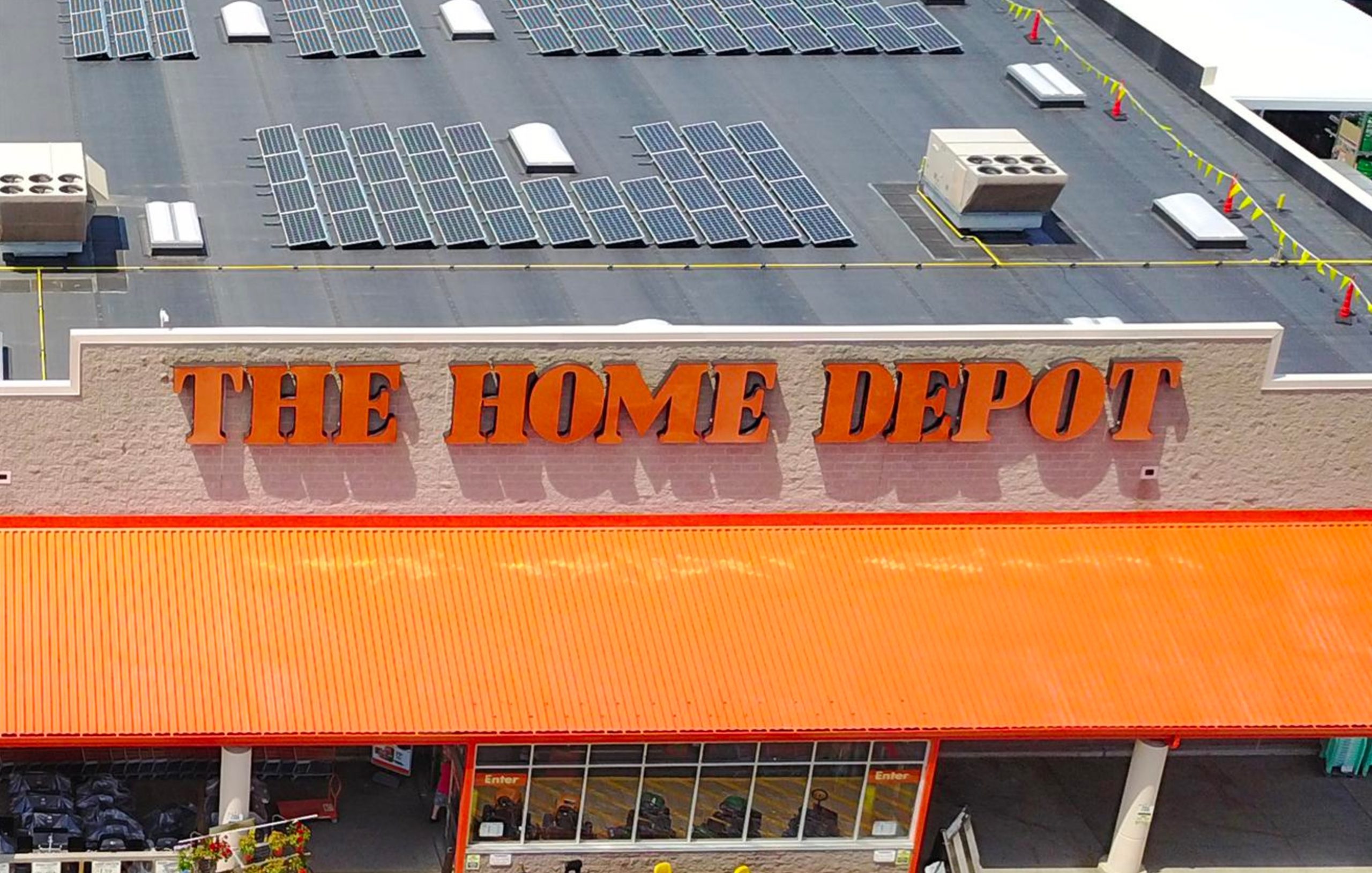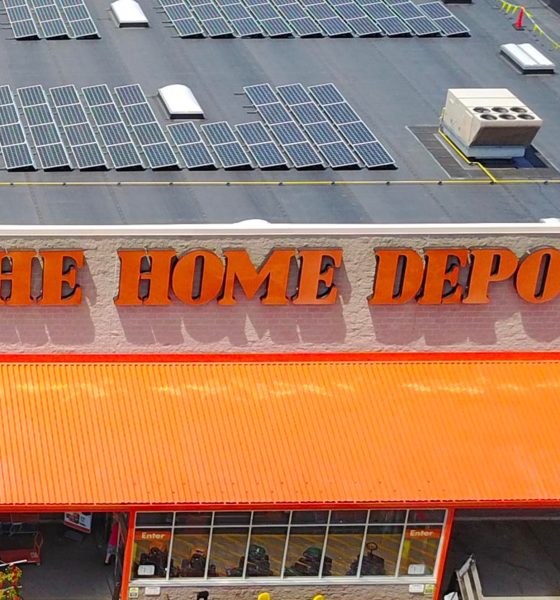

Energy
Tesla to end Home Depot partnership as it closes 12 solar facilities: report
Tesla is closing around a dozen of its solar facilities across nine states in the United States. The closures of the solar sites are reportedly part of the company’s ongoing restructuring, which is set to lay off 9% of Tesla’s workforce.
According to Reuters, the information comes from three internal company documents and statements from seven present and former Tesla employees. The documents accessed by the publication state that the latest cuts to the division come from a part of the company that was once SolarCity. Tesla’s partnership with Home Depot to push sales of its solar solutions and Powerwall 2 home batteries is set to be discontinued as well. According to Home Depot spokesman Stephen Holmes, its partnership with Tesla would last through the end of 2018, after which it would continue a partnership with competitor Sunrun in a number of its stores.
An internal company list reviewed by Reuters added that after the closures of the solar facilities, about 60 solar installation sites would remain open. The facilities that will be closed are reportedly located in California, Texas, Maryland, New York, New Jersey, Connecticut, New Hampshire, Delaware, and Arizona. Solar customer service staff at call centers in Utah and Nevada have also been reportedly laid off by the company.

A Tesla Powerwall 2 displayed in a Home Depot outlet. [Credit: Xixu/Twitter]
With the Home Depot partnership terminated, Tesla will now push its solar solutions through its own stores. Personnel from the facilities that are set to be closed are being transferred to other sites as well. In a statement to Reuters, Tesla noted that the company still expects to grow its solar and battery business over time.
“We continue to expect that Tesla’s solar and battery business will be the same size as automotive over the long term. Tesla stores have some of the highest foot traffic of any retail space in the country,” the company said.
While stopping its partnership with Home Depot might come off as alarming, GTM Research analyst Austin Perea noted that the deal might have been discontinued as a means to reduce unnecessary expenses. While the Home Depot partnership accounted for a significant number of solar and energy sales for Tesla, third-party retail partnerships are among the most expensive means of generating sales in the solar industry. According to Perea, the cost of winning a customer through Home Depot could cost up to $7,000 per system, roughly 45% more compared to the national average of $4,000 per installation.
Tesla’s energy business is steadily growing, however. Last month, CTO JB Straubel noted in a statement to Fast Company that Tesla had installed 1 GWh worth of energy storage to date, an impressive figure that was reiterated by Elon Musk during the company’s 2018 Annual Shareholder Meeting. During the investors’ event, Musk noted that Tesla would be doing another 1 GWh project less than a year from now, with more growth set to happen within the next few years. As could be seen in Tesla’s 10-Q form for Q1 2018, the company’s energy and storage revenue increased 92% in the three months ended March 31, 2008 year-on-year, primarily due to the earnings of the 129 MWh Powerpack farm in South Australia, which generated $72.5 million on its own.
Tesla continues to deploy its energy solutions to several projects across the globe. Currently, Tesla is involved in roughly 11,000 projects in Puerto Rico, where it continues to help communities damaged by Hurricane Maria get back on their feet. Tesla is also starting on the beginnings of a virtual power plant in South Australia involving 50,000 residential homes fitted with Powerwall 2 home batteries and residential solar.

Cybertruck
Tesla updates Cybertruck owners about key Powershare feature

Tesla is updating Cybertruck owners on its timeline of a massive feature that has yet to ship: Powershare with Powerwall.
Powershare is a bidirectional charging feature exclusive to Cybertruck, which allows the vehicle’s battery to act as a portable power source for homes, appliances, tools, other EVs, and more. It was announced in late 2023 as part of Tesla’s push into vehicle-to-everything energy sharing, and acting as a giant portable charger is the main advantage, as it can provide backup power during outages.
Cybertruck’s Powershare system supports both vehicle-to-load (V2L) and vehicle-to-home (V2H), making it flexible and well-rounded for a variety of applications.
However, even though the feature was promised with Cybertruck, it has yet to be shipped to vehicles. Tesla communicated with owners through email recently regarding Powershare with Powerwall, which essentially has the pickup act as an extended battery.
Powerwall discharge would be prioritized before tapping into the truck’s larger pack.
However, Tesla is still working on getting the feature out to owners, an email said:
“We’re writing to let you know that the Powershare with Powerwall feature is still in development and is now scheduled for release in mid-2026.
This new release date gives us additional time to design and test this feature, ensuring its ability to communicate and optimize energy sharing between your vehicle and many configurations and generations of Powerwall. We are also using this time to develop additional Powershare features that will help us continue to accelerate the world’s transition to sustainable energy.”
Owners have expressed some real disappointment in Tesla’s continuous delays in releasing the feature, as it was expected to be released by late 2024, but now has been pushed back several times to mid-2026, according to the email.
Foundation Series Cybertruck buyers paid extra, expecting the feature to be rolled out with their vehicle upon pickup.
Cybertruck’s Lead Engineer, Wes Morrill, even commented on the holdup:
As a Cybertruck owner who also has Powerwall, I empathize with the disappointed comments.
To their credit, the team has delivered powershare functionality to Cybertruck customers who otherwise have no backup with development of the powershare gateway. As well as those with solar…
— Wes (@wmorrill3) December 12, 2025
He said that “it turned out to be much harder than anticipated to make powershare work seamlessly with existing Powerwalls through existing wall connectors. Two grid-forming devices need to negotiate who will form and who will follow, depending on the state of charge of each, and they need to do this without a network and through multiple generations of hardware, and test and validate this process through rigorous certifications to ensure grid safety.”
It’s nice to see the transparency, but it is justified for some Cybertruck owners to feel like they’ve been bait-and-switched.
Energy
Tesla starts hiring efforts for Texas Megafactory
Tesla’s Brookshire site is expected to produce 10,000 Megapacks annually, equal to 40 gigawatt hours of energy storage.

Tesla has officially begun hiring for its new $200 million Megafactory in Brookshire, Texas, a manufacturing hub expected to employ 1,500 people by 2028. The facility, which will build Tesla’s grid-scale Megapack batteries, is part of the company’s growing energy storage footprint.
Tesla’s hiring efforts for the Texas Megafactory are hinted at by the job openings currently active on the company’s Careers website.
Tesla’s Texas Megafactory
Tesla’s Brookshire site is expected to produce 10,000 Megapacks annually, equal to 40 gigawatt hours of energy storage, similar to the Lathrop Megafactory in California. Tesla’s Careers website currently lists over 30 job openings for the site, from engineers, welders, and project managers. Each of the openings is listed for Brookshire, Texas.
The company has leased two buildings in Empire West Business Park, with over $194 million in combined property and equipment investment. Tesla’s agreement with Waller County includes a 60% property tax abatement, contingent on meeting employment benchmarks: 375 jobs by 2026, 750 by 2027, and 1,500 by 2028, as noted in a report from the Houston Business Journal. Tesla is required to employ at least 1,500 workers in the facility through the rest of the 10-year abatement period.
Tesla’s clean energy boom
City officials have stated that Tesla’s arrival marks a turning point for the Texas city, as it highlights a shift from logistics to advanced clean energy manufacturing. Ramiro Bautista from Brookshire’s economic development office, highlighted this in a comment to the Journal.
“(Tesla) has great-paying jobs. Not just that, but the advanced manufacturing (and) clean energy is coming to the area,” he said. “So it’s not just your normal logistics manufacturing. This is advanced manufacturing coming to this area, and this brings a different type of job and investment into the local economy.”
Energy
Tesla and Samsung SDI in talks over new US battery storage deal: report
The update was related by industry sources and initially reported by South Korean news outlets.

Recent reports have suggested that Tesla and Samsung SDI are in talks over a potential partnership to supply batteries for large-scale energy storage systems (ESS).
The update was related by industry sources and initially reported by South Korean news outlets.
ESS batteries to be built at Samsung’s Indiana plant
As noted in a report from Korea JoongAng Daily, the demand for energy storage systems has been growing rapidly in North America, thanks in no small part to the surge in AI investments across numerous companies. With this in mind, Tesla has reportedly approached Samsung SDI about a potential battery supply deal.
The deal is reportedly worth over 3 trillion Korean won (approximately $2.11 billion) and will span three years, according to The Korea Global Economic Daily. A battery supply deal with Samsung SDI could make sense for Tesla as the company already has a grid-scale battery, the Megapack, which is perfect for industrial use. Samsung SDI could simply supply cells for the EV maker.
Production of the batteries would reportedly take place at Samsung SDI’s joint venture factory with Stellantis in Indiana, which is currently under construction. Samsung SDI recently announced plans to use part of that plant’s EV lines to produce cells for ESS, with a targeted capacity of 30 GWh by the end of next year.
Tesla and Samsung’s partnership
At present, only a handful of manufacturers, including Korea’s LG Energy Solution, Samsung SDI, SK On, and Japan’s Panasonic, are capable of producing energy storage-scale batteries domestically in the United States. A Samsung SDI official issued a comment about the matter, stating, “Nothing has been finalized regarding cooperation with Tesla.”
The possible energy storage system deal adds another layer to Tesla’s growing collaboration with Samsung, which is already in line as a partner in the upcoming production of Tesla’s AI5 and AI6 chips. Early sample manufacturing of the AI6 is expected to begin in South Korea, with mass production slated for Samsung’s Texas-based Taylor foundry when it starts operations.
The AI6 chip will power Tesla’s next wave of high-volume projects, including the Optimus humanoid robot and the autonomous Cybercab service. Musk has called the partnership with Samsung a “real collaboration,” adding that he personally plans to “walk the line” at the Taylor facility to speed up progress.








